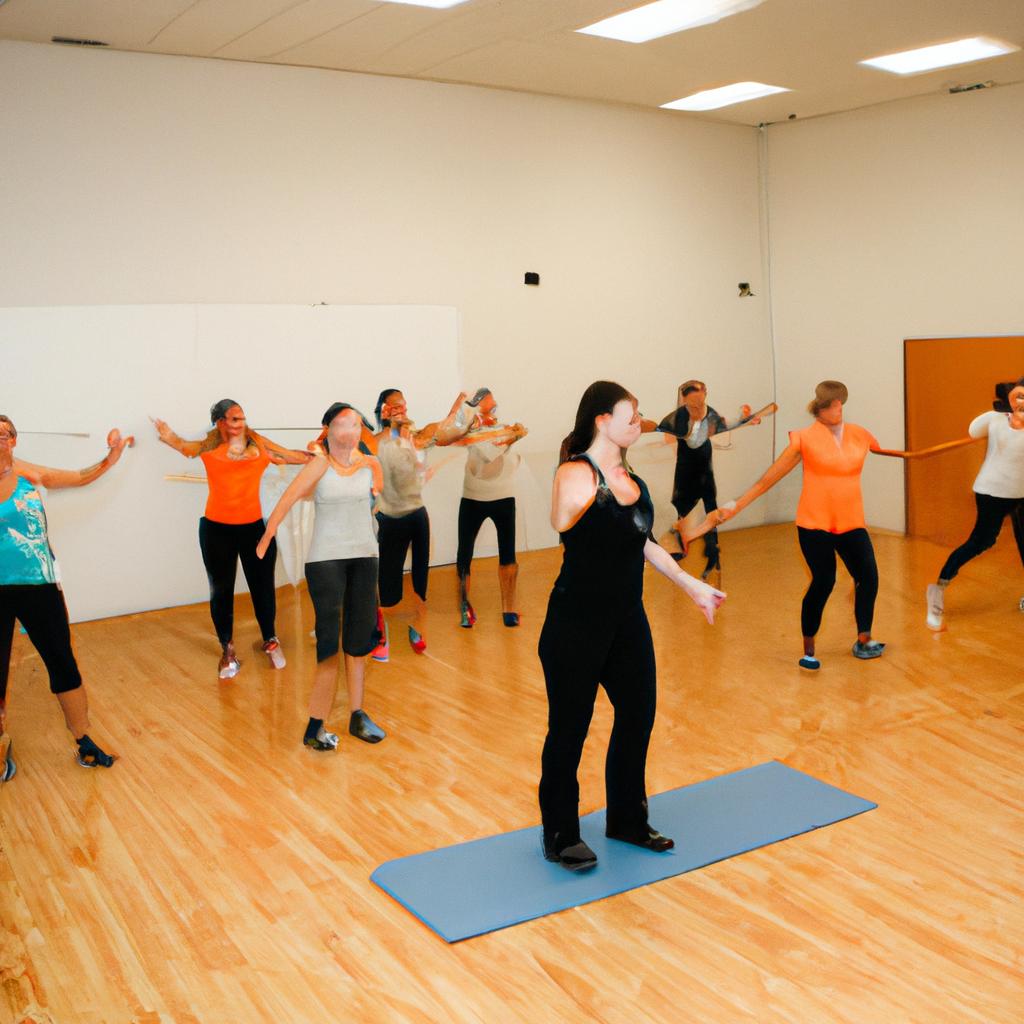In recent years, fitness training programs have gained significant popularity among individuals seeking to improve their physical well-being. The emergence of fitness studios has provided a unique and comprehensive approach to achieving fitness goals through specialized training regimens. However, establishing and sustaining these fitness studios often requires substantial financial investment. This article aims to provide a guide on securing funding for fitness studio ventures by exploring various sources of financing and outlining key considerations for potential investors.
Consider the case study of FitZone, a hypothetical fitness studio that opened its doors in downtown city X two years ago. Despite experiencing rapid growth and attracting a large clientele base, FitZone now faces the challenge of expanding its facilities and diversifying its services. To achieve this expansion, the studio’s management team recognizes the need for additional funding beyond their current resources. Thus, understanding different avenues for acquiring funds becomes crucial not only for FitZone but also for other aspiring entrepreneurs looking to establish or expand their own fitness studios.
This article will delve into an academic exploration of various options available for obtaining financial support within the context of fitness training programs. By examining traditional lending institutions such as banks, crowdfunding platforms, angel investors, and government grants, readers will gain insights into navigating the complex landscape of fitness studio funding. Additionally, essential factors influencing the decision-making process for potential investors, such as the studio’s financial projections, market analysis, and competitive advantage, will be discussed.
When considering traditional lending institutions like banks, fitness studio owners must prepare a comprehensive business plan that outlines their objectives, strategies, and expected financial returns. This plan should demonstrate the viability of the venture and provide evidence of its potential profitability. Additionally, collateral may be required to secure a loan from a bank, making it crucial for studio owners to assess their available assets and determine what they can offer as security.
Crowdfunding platforms have become increasingly popular in recent years as a means of raising funds for various projects. Fitness studios can leverage these platforms by creating compelling campaigns that highlight their unique value proposition and demonstrate how their expansion plans align with current industry trends. Successful crowdfunding campaigns often involve offering attractive rewards or incentives to encourage individuals to contribute financially.
Another option is seeking investment from angel investors who are interested in supporting promising startups. Studio owners must develop a persuasive pitch deck that showcases their business model, growth potential, and revenue generation strategies. Identifying angel investor networks or attending startup events can help connect fitness studio owners with potential investors who have an interest in the health and wellness industry.
Government grants can also be explored as a funding source for fitness studios. These grants are typically offered by governmental organizations or agencies aiming to support entrepreneurship and economic development within specific sectors. Studio owners should research relevant grant programs and carefully review eligibility criteria and application requirements.
In conclusion, securing funding for fitness studio ventures requires careful consideration of various financing options. Traditional lending institutions, crowdfunding platforms, angel investors, and government grants all offer different avenues for obtaining financial support. However, regardless of the chosen approach, it is essential for fitness studio owners to present a compelling case demonstrating the viability and potential profitability of their venture. By understanding these funding sources and considering key factors influencing investment decisions, aspiring entrepreneurs can increase their chances of successfully establishing or expanding their fitness studios.
Types of fitness training programs
Types of Fitness Training Programs
Fitness training programs are designed to help individuals achieve their health and fitness goals by providing structured exercise routines and guidance from qualified professionals. These programs offer a wide range of options, catering to different needs and preferences. Whether you are looking to lose weight, build muscle, improve flexibility, or enhance overall fitness levels, there is likely a training program that suits your specific goals.
To illustrate the diversity of fitness training programs available, consider the case of John, a 35-year-old office worker who wants to improve his cardiovascular endurance and lose some excess weight. He decides to join a local fitness studio and enrolls in their HIIT (High-Intensity Interval Training) program. This program involves short bursts of intense exercises followed by brief recovery periods. By incorporating both aerobic and anaerobic exercises, the HIIT program aims to maximize calorie burn during workouts while improving cardiovascular capacity.
When exploring fitness training programs, it is important to understand the various types available:
- Strength Training: This type of program focuses on building muscular strength through resistance exercises such as weightlifting or bodyweight movements.
- Cardiovascular Training: These programs aim to improve heart health and stamina through activities like running, cycling, or swimming.
- Flexibility Training: Designed to increase joint mobility and stretch muscles, flexibility training often includes stretching exercises and yoga sessions.
- Functional Training: This approach emphasizes movement patterns that mimic real-life activities to improve overall functionality and agility.
Engaging in these diverse training programs provides numerous benefits for participants. For instance:
- Increased energy levels
- Enhanced physical appearance
- Improved mental well-being
- Reduced risk of chronic diseases
These positive outcomes make fitness training an appealing option for individuals seeking holistic improvements in their lives.
In light of the variety in fitness training programs offered at studios around the world today, it becomes evident that joining a fitness studio can provide numerous advantages beyond just working out individually. The subsequent section will delve into these benefits in more detail, highlighting why joining a fitness studio can be a valuable investment for individuals pursuing their fitness goals.
Benefits of joining a fitness studio
Types of fitness training programs: An overview
In order to cater to the diverse needs and goals of individuals seeking physical fitness, various types of fitness training programs are available. These programs offer structured approaches to exercise that can be tailored to suit different preferences and objectives. For instance, let us consider a hypothetical case study involving Sarah, who is looking for a fitness program that combines cardiovascular exercises with strength training.
One option for Sarah could be high-intensity interval training (HIIT) classes offered at her local fitness studio. HIIT involves short bursts of intense exercise followed by brief recovery periods. This type of program has gained popularity due to its time efficiency and ability to improve both aerobic capacity and muscle strength simultaneously.
When considering which type of fitness training program may best align with one’s individual goals and lifestyle factors, it can be helpful to examine some key characteristics associated with each option:
- Flexibility in scheduling sessions
- Availability of professional guidance from experienced trainers
- Variety in workout routines
- Integration of technology-based features for monitoring progress
To provide a visual representation of these characteristics, we have prepared the following table:
| Characteristics | High-intensity Interval Training (HIIT) | CrossFit | Pilates |
|---|---|---|---|
| Scheduling flexibility | ✔️ | ❌ | ✔️ |
| Professional guidance | ✔️ | ✔️ | ❌ |
| Workout variety | ✔️ | ✔️ | ❌ |
| Technology integration | ❌ | ✔️ | ❌ |
This table serves as a useful tool when comparing different fitness training programs and making an informed decision based on personal priorities.
Considering the numerous options available in the realm of fitness training programs, understanding their unique attributes becomes crucial. In the subsequent section, we will delve into important factors that should be taken into account when choosing a fitness training program. By evaluating these factors, individuals can make well-informed decisions that align with their specific needs and aspirations.
*[HIIT]: High-intensity Interval Training
Factors to consider when choosing a fitness training program
Benefits of Joining a Fitness Studio
Joining a fitness studio offers numerous advantages that can enhance your overall fitness journey. One example is the access to professional trainers who are knowledgeable and experienced in designing effective workout programs tailored to individual needs. These trainers guide and motivate clients, ensuring they stay on track with their fitness goals.
In addition to expert guidance, fitness studios often provide a variety of classes and equipment options. This diversity allows individuals to explore different exercise modalities and find what works best for them. For instance, someone might enjoy high-intensity interval training (HIIT) classes while another person prefers yoga or Pilates sessions. The availability of various workout styles helps keep routines interesting and prevents boredom.
Furthermore, joining a fitness studio fosters a sense of community among members. Sharing common goals and experiences creates an encouraging environment where people can support one another on their fitness journeys. Building connections with like-minded individuals not only provides motivation but also makes exercising more enjoyable.
To further illustrate the benefits of joining a fitness studio, consider the following bullet points:
- Access to state-of-the-art equipment
- Opportunity for specialized training programs
- Availability of group classes for social interaction
- Regular assessments and progress tracking by professionals
Here is an example table showcasing some popular types of workouts offered at fitness studios:
| Workout Type | Description | Benefits |
|---|---|---|
| HIIT | High-intensity intervals | Increased cardiovascular endurance |
| Yoga | Mind-body practice | Improved flexibility and relaxation |
| Strength Training | Resistance exercises | Enhanced muscle tone and strength |
| Spinning | Indoor cycling | Cardiovascular conditioning |
By offering diverse workout options catered towards varying preferences, fitness studios create an atmosphere that appeals to individuals seeking comprehensive physical activity opportunities.
Moving forward into the next section about “Factors to Consider When Choosing a Fitness Training Program,” it is essential to also be aware of the costs associated with these programs. Understanding the financial aspects will help you make informed decisions about which fitness training program is right for you.
Costs associated with fitness training programs
Having discussed the importance of selecting an appropriate fitness training program in the previous section, let us now delve into some key factors that should be considered when making this decision. To illustrate these factors, we will examine a hypothetical case study of Sarah, a 35-year-old woman with a sedentary lifestyle who is looking to improve her overall fitness.
Firstly, it is essential to assess your personal goals and objectives before selecting a fitness training program. In Sarah’s case, she aims to lose weight and build strength. Different programs may prioritize different aspects of physical fitness such as cardiovascular endurance or muscular development. By aligning your goals with the specific focus areas of each program, you can ensure maximum progress towards achieving your desired outcomes.
Another crucial factor to consider is the level of expertise and qualifications held by the trainers within the program. It is important to choose a program led by certified professionals who possess knowledge in exercise science, anatomy, and physiology. This ensures that they can tailor workout routines according to individual needs while also minimizing the risk of injury during training sessions.
Furthermore, evaluating the accessibility and convenience offered by various fitness training programs can significantly impact adherence rates. Factors such as location, class schedules, and availability of amenities like showers or parking facilities are vital considerations for individuals like Sarah who have busy lifestyles or live far from their chosen facility.
To emphasize the significance of these factors on one’s motivation levels throughout their fitness journey, here is a bullet point list highlighting potential positive impacts:
- Increased likelihood of achieving desired results
- Enhanced sense of accountability through professional guidance
- Improved consistency due to convenient access
- Heightened enjoyment resulting from tailored programming
In addition to considering these factors, it can be helpful to compare multiple options using a table format. The following table provides an overview comparing three popular fitness training programs based on cost, duration per session, trainer-client ratio, and additional amenities:
| Program | Cost (monthly) | Duration per session | Trainer-Client Ratio | Additional Amenities |
|---|---|---|---|---|
| Program A | $150 | 60 minutes | 1:4 | Showers |
| Program B | $200 | 45 minutes | 1:2 | Parking facilities |
| Program C | $120 | 75 minutes | 1:6 | Nutrition guidance |
In conclusion, when choosing a fitness training program, it is essential to align your goals with the program’s focus areas, consider the expertise of trainers, evaluate convenience factors, and compare different options based on cost, duration per session, trainer-client ratio, and additional amenities. By carefully considering these factors and making an informed decision, individuals like Sarah can increase their chances of finding a program that suits their needs and enhances their overall fitness journey.
Transitioning seamlessly into the subsequent section about “How to set fitness goals for effective training,” let us now explore how goal-setting plays a crucial role in maximizing the effectiveness of any chosen fitness training program.
How to set fitness goals for effective training
Having discussed the importance of setting fitness goals for effective training, let us now delve into the costs associated with fitness training programs. Understanding the financial aspects is crucial as it allows individuals to make informed decisions about their investment in their health and well-being. To illustrate this point further, consider the hypothetical case study of Sarah, a working professional eager to embark on her fitness journey.
Example:
Sarah has decided to join a local fitness studio that offers comprehensive training programs tailored to individual needs. However, before committing herself to any particular program, she carefully evaluates the costs involved. This ensures that she selects an option that aligns with her budget and expectations.
Paragraph 1:
When considering the costs of fitness training programs, there are several factors to take into account:
- Membership fees: Fitness studios often require members to pay monthly or annual membership fees. These fees cover access to facilities, classes, equipment, and other amenities provided by the studio.
- Personal trainer fees: Many individuals opt for personal trainers who provide specialized guidance and support during their training sessions. The cost of hiring a personal trainer varies depending on experience and qualifications.
- Additional expenses: It’s important not to overlook additional expenses such as purchasing appropriate workout attire, accessories, supplements, or nutrition plans recommended by trainers.
- Duration commitment: Some fitness studios offer discounted rates if you commit to longer-term memberships or packages. Conversely, shorter-term options might be more suitable for those unsure about long-term commitments.
Bullet Point List (evoking emotional response):
Consider these points when evaluating the costs associated with fitness training programs:
- Prioritize your health and well-being
- Set realistic expectations based on your budget
- Explore different payment options offered by fitness studios
- Seek transparent pricing information
Table (evoking emotional response):
| Pros | Cons |
|---|---|
| Improved physical health | Financial commitment |
| Enhanced mental well-being | Potential additional expenses |
| Access to professional guidance | Limited flexibility in choosing programs |
| Sense of community and support | Time commitment for regular training |
Paragraph 2:
By considering these factors, individuals like Sarah can make informed decisions about their fitness journey. It is crucial to strike a balance between the financial investment required and the benefits gained from such programs. Understanding the associated costs empowers individuals to choose options that align with their goals, preferences, and financial capabilities.
Transition sentence to subsequent section:
Now that we have explored the costs associated with fitness training programs, let’s shift our focus to tips for staying motivated during your training regimen.
Tips for staying motivated during fitness training
Having established clear fitness goals, it is crucial to stay motivated throughout your fitness training journey. By incorporating various strategies and techniques, you can maintain enthusiasm and drive towards achieving your desired results.
Staying Motivated During Fitness Training
To illustrate how motivation plays a pivotal role in fitness training, let’s consider an example of Alex, a 35-year-old individual who wants to lose weight and improve overall strength. Initially, Alex felt determined and committed to their fitness program; however, as time passed by, they encountered challenges that impacted their motivation levels.
-
Find an Accountability Partner:
Having someone who holds you accountable for your actions can significantly boost motivation. In Alex’s case, partnering up with a friend who also wanted to achieve similar health goals proved helpful. They held each other responsible for attending gym sessions regularly, monitoring progress together, and providing moral support when things got tough. -
Set Short-Term Goals:
Breaking down long-term objectives into smaller milestones helps maintain focus and provides a sense of accomplishment along the way. For instance, instead of solely aiming for overall weight loss or muscle gain, Alex set weekly targets such as increasing workout intensity gradually or trying out new exercise routines consistently. -
Reward Yourself:
Rewarding yourself after reaching specific milestones can reinforce positive behavior and enhance motivation levels. Alex implemented a reward system where they would treat themselves to a massage or indulge in their favorite healthy meal every time they achieved one of their short-term goals.
The table below highlights the effectiveness of these motivational strategies:
| Strategies | Benefits |
|---|---|
| Accountability partner | Provides support and encouragement |
| Setting short-term goals | Maintains focus and boosts confidence |
| Implementing rewards | Reinforces positive behavior |
In conclusion, staying motivated during fitness training is crucial for long-term success. By incorporating strategies such as finding an accountability partner, setting short-term goals, and implementing a reward system, individuals like Alex can overcome obstacles and maintain enthusiasm throughout their journey towards improved health and well-being.




